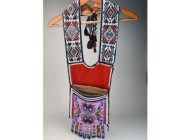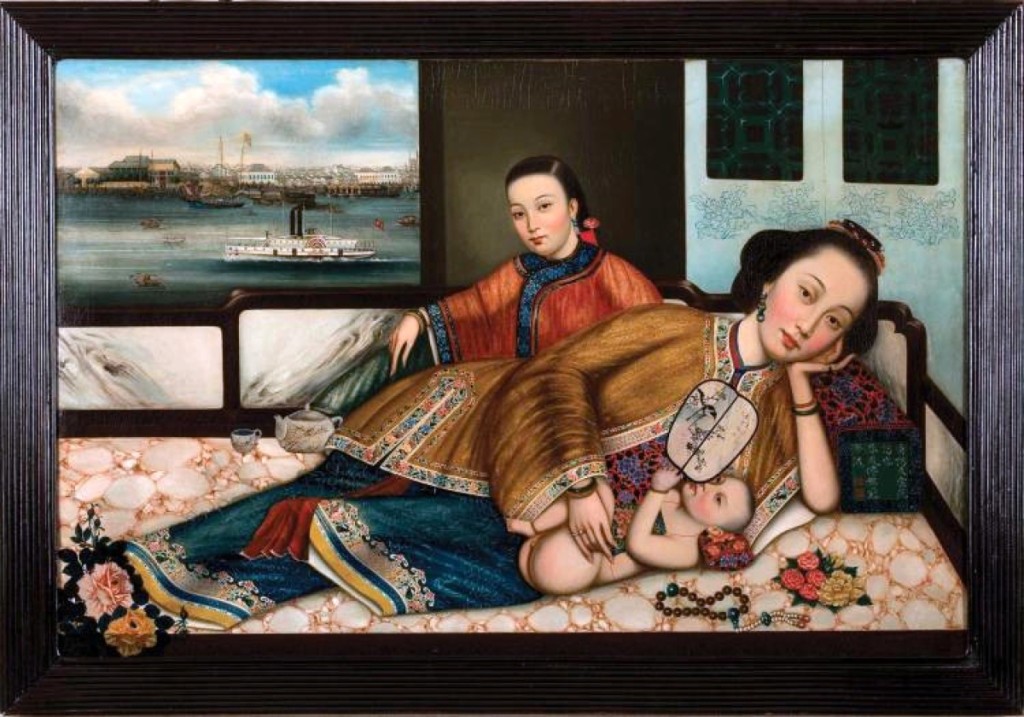
The top priced item in the sale was a large China trade painting of a mother and her child, with a view of the Canton waterfront in the background. Circa 1870, it depicted a Chinese woman and her infant son, with an attendant close at hand. It sold for $102,000.
Review and Onsite Photos by Rick Russack, Additional Photos Courtesy of Northeast Auctions
PORTSMOUTH, N.H. – Estimates meant nothing to the phone bidders and the 100 or so bidders in the tent at Northeast Auctions’ American furniture and folk art, marine and China trade sale, August 18-20. For example, on page 54 of the informative catalog, six tin and brass lanterns are shown. Collectively, the high estimates for the six pieces totaled $2,850. They sold, collectively, for $20,640. At times, eight phone lines were active on the same lot, as when the first lot, a miniature portrait of a young girl by Clarissa Peters Russell (American, 1809-1854) sold for $36,000, more than four times the estimate.
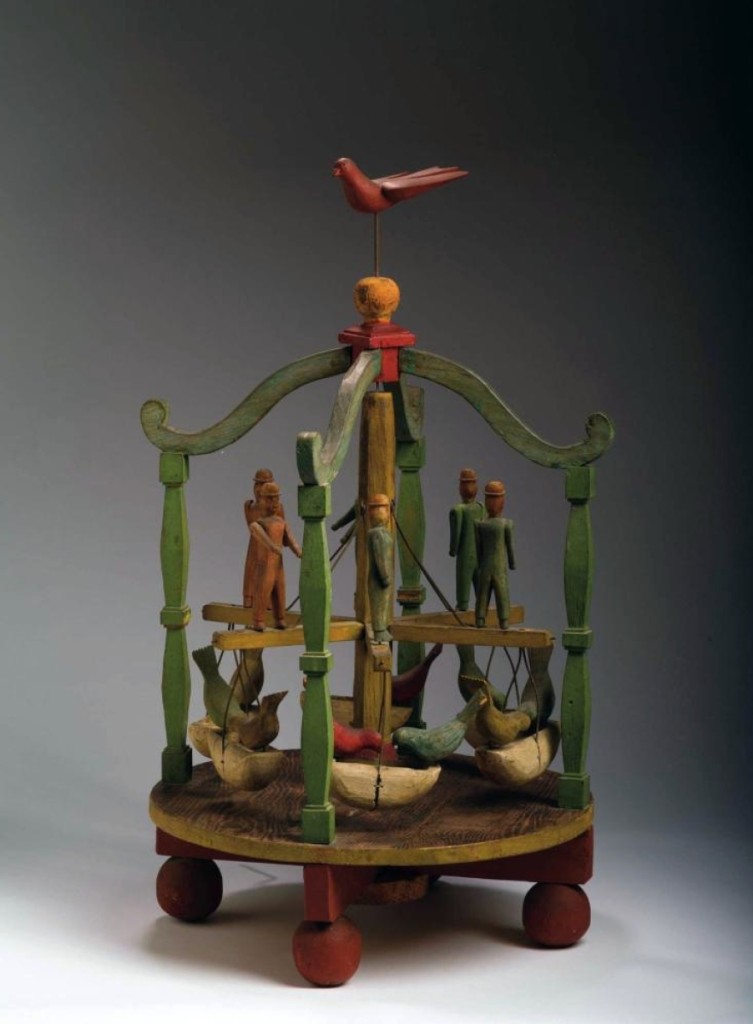
One of the highest priced items in the three-day sale was a carved and painted wood “Carrousel For Birds and Men.” It was done by famed Pennsylvania wood carver John Scholl and had been illustrated in Celebrations in Wood, a catalog of his work. It went to a phone bidder for $90,000.
Much of the material on the first day came from a local collection that had been started in 1974 when the collector bought an early engraving of Israel Putnam for $235 from Portsmouth dealer Hollis Brodrick. That collection included a wide selection of Revolutionary War-era firearms and swords, as well as many Eighteenth Century portrait prints of historical people and paintings. Day one also included about 90 lots from the estate of a Charles Street, Boston, antiques dealer that had been packed away for more than 70 years. The day before the sale, auctioneer Ron Bourgeault said, “We’ve had more than 600 inquiries and presale bids, more than we’ve ever had before.” The second day of the sale was devoted to the collection of Doris and Stanley Tananbaum and included early furniture, weathervanes, windmill weights, Bennington pottery, canary yellowware, cigar store Indians, folk art paintings, early lighting, brass and silver.
It may be safe to say that life has returned to the market for good Americana and folk art. Dealers at the seven shows that comprised Antiques Week in New Hampshire almost universally reported strong sales, increased interest and enthusiasm on the part of buyers. Skinner’s Americana sale, the week before the Northeast sale, saw strong results, and also had a record number of bidders lined up before the sale. And this Northeast sale was well attended by an enthusiastic crowd, and strong prices prevailed in all categories.
Topping the three-day sale was a large China trade painting of a Chinese mother and her infant son, circa 1870, which brought $102,000. The mother’s attendant is behind her, and the mother is depicted reclining on a mother-of-pearl and marble inlaid bed. In the background is a view of the Canton waterfront. Other China trade material also performed well. A black lacquered and gilt-decorated slant lid desk with a pierced gallery and three small drawers sold for $12,600. A painting of an American sailing vessel by Sunqua (Chinese, active 1830-65) earned $18,600. Porcelains from the Hatcher cargo and other sources did well, with two late Ming, blue and white Kraak bottle vases, circa 1640, finishing at $15,000, and a China trade silver presentation ewer, chased with landscape panels and battle scenes, earned $9,360.
While the China trade material was strong, the Americana offerings drew the crowd and saw multiple bidders competing for nearly all lots. The sale began with about 90 lots from the estate of Philip Rosenberg, a Charles Street antiques dealer who died in 1951. When in failing health, Rosenberg closed his shop and the contents of the shop were put into storage, where they remained until this year. The portrait miniature mentioned above came from this group, which also included English ceramics and Pennsylvania redware. A slip-decorated and sgraffito dish attributed to Frederick township, Montgomery County, Penn., dated 1793 and decorated with flowers and a German proverb, reached $34,800, almost four times the estimate. A 19½-inch English creamware charger with a red transfer of a scene from the Trojan Wars brought $4,560. The Rosenberg material included New England redware and hooked rugs. Henry Davis Sleeper (of Beauport fame) was a customer for hooked rugs, and the Charles Street dealers in those days were often visited by collectors such as Henry Ford, Henry Francis DuPont and Ima Hogg. A New England red-painted comb-back writing arm Windsor from this collection achieved $5,100.
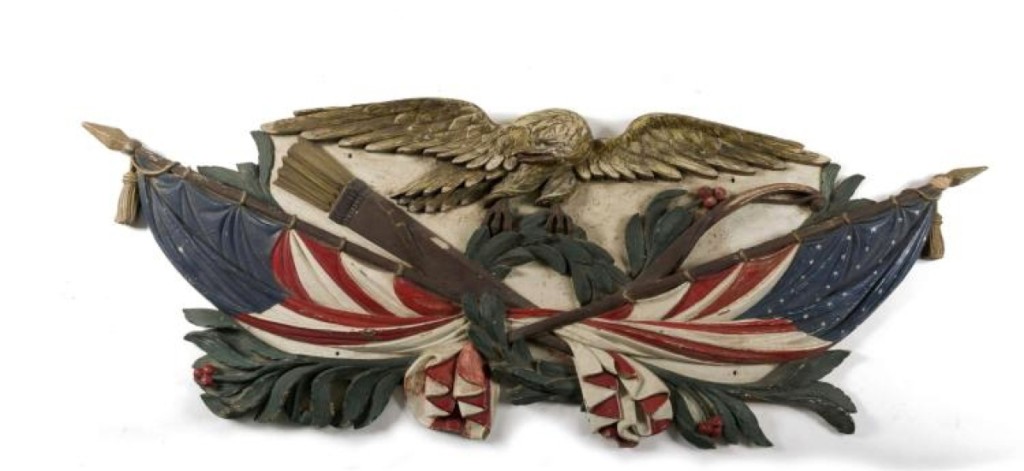
An 81-inch-long carved and painted ship’s sternboard realized $60,000. A displayed eagle was perched on a garland of olive branches above crossed American flags.
This sale included more than 100 lots of Eighteenth Century historical engravings, Revolutionary War-era swords and firearms and more. It was just a part of the collection of a Portsmouth resident. As with other parts of this sale, estimates were surpassed over and over. The first lot of this group was a political and satirical print titled “The Bostonian’s Paying the Excise-Man, or Tarring and Feathering,” 1774. It was a mezzotint engraving attributed to Philip Dawe and published in London. Five phone bidders competed with two in the room until it reached $31,200, against an estimate of $5,000. Another by the same hand, “The Bostonians in Distress,” also 1774, brought even more, $36,000 against a $5,000 estimate.
This collection included more than 90 lots of firearms and swords from the Revolutionary War era and the early years of the new republic. It had been well promoted, as Bourgeault had taken most of the collection to the recent show and sale conducted by the New England Arms Society in Sturbridge, Mass. The collector had been assisted in building his collection by Brodrick, who bought back several of the items. One of the weapons that Brodrick bought was a French military musket, marked on the barrel “New Hampshire Third Battalion.” This musket was part of a shipment that arrived on a French ship in 1777, and because the port of Boston had been closed by the British, these weapons were seized by New Hampshire, and each was marked by John Ward Gilman of Exeter, N.H. During the war years, Exeter was the capital of New Hampshire. The weapons were supplied to New Hampshire battalions, which served at Saratoga when Burgoyne’s troops surrendered. Brodrick paid $6,300.
The top lot of the collection was a Long Land “First Model Brown Bess” with a lock stamped “Farmer 1744,” which went for $24,000. Many of these weapons were made of parts supplied by France. According to Don Koleman, who cataloged the collection for Northeast, when Benjamin Franklin persuaded the French to assist the colonists, they sent numerous older weapons and parts that were assembled by gunsmiths in America. A rare English flintlock holster Dragoon pistol, with the same 1744 stamp on the lock, fetched $13,200.
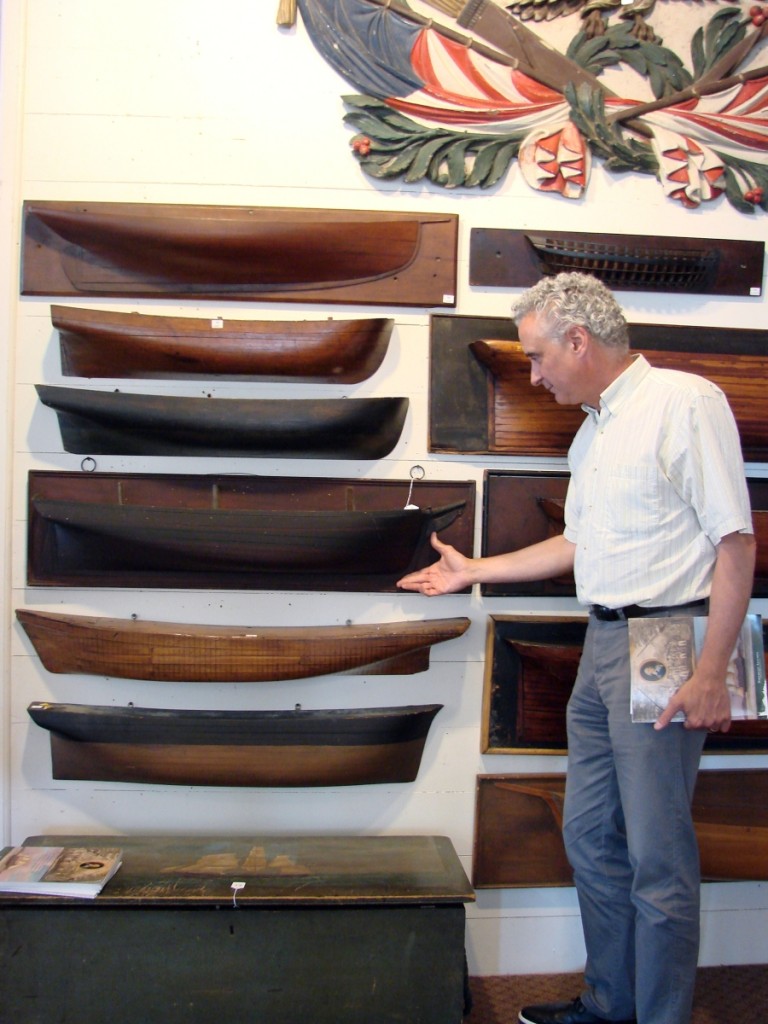
Curator of maritime art and history at the Peabody Essex Museum Dan Finamore examines some of the half-hull ship models.
The collections of Doris and Stanley Tananbaum comprised the second day of the sale. The couple had started to collect in the 1940s and they liked early furniture, cabinetmaker’s miniatures, early lighting, folk art, lighting and ceramics. The first item they bought, a four-post bed, was included in the sale and sold for $1,680. As with the sale in general, catalog estimates meant nothing. For example, the first of their pieces, a blue-painted pine, cant-back hanging cupboard, estimated $4,000, brought $14,400, followed a few minutes later by a portrait of a boy in a blue suit, holding a puppy. It had been cataloged as Prior-Hamblin School and estimated at $8,000. Bourgeault announced from the podium that a Prior signature had been found on the frame, and it earned $45,600. A miniature Chippendale slant-front desk and bookcase, with two inset heart-shaped fraktur, estimated at $4,000, finished at $33,600. It was 29½ inches tall. Other miniatures did well, with a Cotton Hersey, Hingham, miniature wood bucket in old paint, with two fingers and carrying handles, reaching $16,800. Stanley Tananbaum liked Bennington and Rockingham pottery, and several pieces were included in the sale. A rare Bennington flint-enamel fluid lamp, pictured in Richard Carter Barret’s Bennington Pottery and Porcelain, went for $5,640, while an unusual flint-enamel figural group of a boy and his dog, also discussed in the Barret book, earned $2,520. An important Staffordshire enamel decorated and black-transfer printed jug of Southern interest will be going to the Museum of Early Southern Decorative Arts (MESDA), Winston-Salem, N.C. The transfer depicts Shell Castle port, circa 1795-1806, and it has a medallion with a wreath enclosing “Peace and Independence.” Shell Castle port has a short but fascinating history, too long for this article but worth an internet search. Phil Zea, president of Historic Deerfield, bought it for $42,000 for an unnamed collector. He said it was a “promised gift to MESDA.”
Tananbaum folk art included several trade signs, cigar store Indians, weathervanes and windmill weights. An unusual trade sign, a cast iron figure of a pig, probably meant for use on a counter as it opened to show the various cuts of pork, sold for $8,640. Another, 28 inches tall, was a carved and painted sign in the form of a pewter teapot, probably a pewterer’s trade sign, and it fetched $13,800. Windmill weights in nice condition ranged from $540 for a small rooster to $1,680 for a large rooster and a “Hanchette Bull.” A full-bodied 41-inch cow weathervane, painted yellow, brought $14,400, and a full-bodied bull, 50 inches long, finished a little lower, at $11,400. The selection of formal furniture was topped by a blockfront chest of drawers that had been pictured in the catalog of the John Brown House Loan Exhibition of Rhode Island furniture in 1965. It sold for $37,200. A set of 12 New York Federal carved mahogany dining chairs, circa 1790-1805, earned $19,200. One could continue highpoints from the Tananbaum collection, which had its own separate catalog; there were many and the collection totaled $1.164 million.
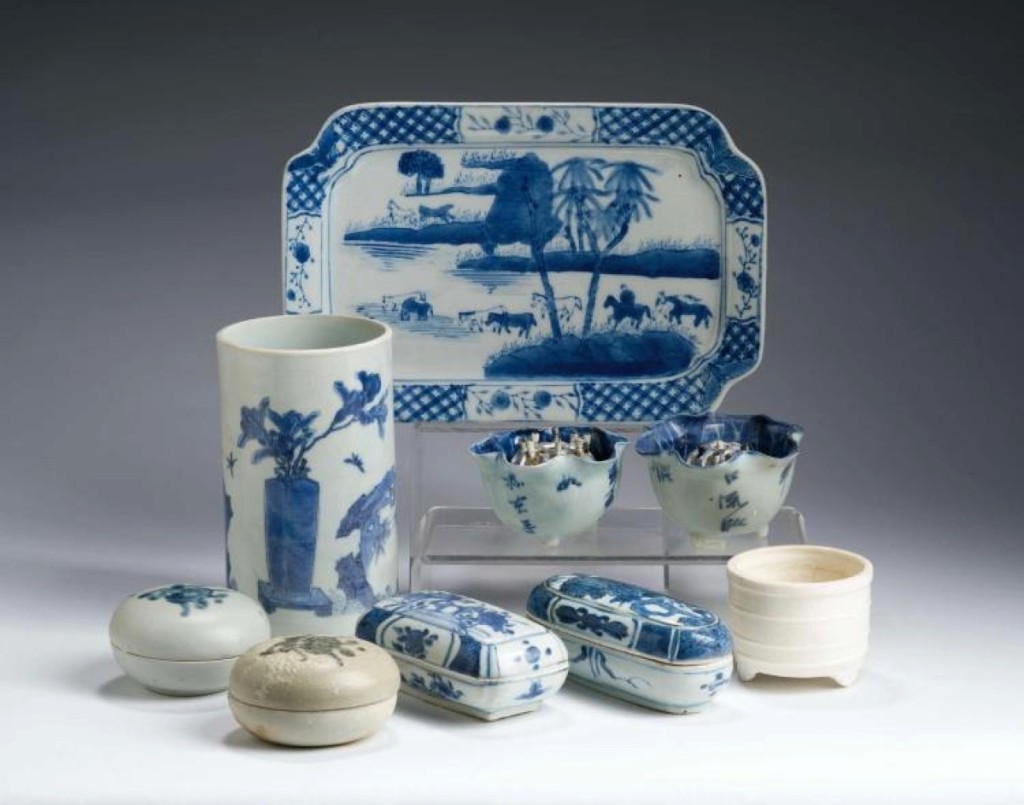
The sale included several lots of Chinese porcelains, including several pieces from the Hatcher cargo. A group of nine late Ming blue and white “Kraak” and transitional porcelains salvaged by Captain Hatcher in 1985 realized $52,800.
The third day offered Currier and Ives prints, including two rare San Francisco views. A large folio “The City of San Francisco,” a bird’s-eye view from the Bay looking southwest, realized $10,800, and a “View of San Francisco, California, Taken From Telegraph Hill” went out for $12,000. Bringing the third highest price of the three-day sale was a 1906 crayon, charcoal, pen and ink work by George Bellows (American, 1882-1925), “The Watermelon Man,” selling for $67,200. The sale included some items of Portsmouth interest. A Worthington Whittredge (American, 1820-1891) painting of the interior of the house now known as the Macpheadris-Warner house, the oldest brick home in Portsmouth, finished at $7,200 and will stay in New Hampshire. A miniature deck-top chest of drawers, signed by Samuel Parmare(?) Treadwell, 1838, reached $2,640. The Portsmouth Historical Society had hoped to acquire it but was not successful. An exceptional folk art “Carrousel For Birds and Men” by noted Pennsylvania carver John Scholl, (1827-1916), took its place as the second highest price of the sale, achieving $90,000.
Also on the third day, two cigar store Indians were sold. An outstanding chief, more than 6 feet tall, with a feather headdress and holding a tobacco leaf, carved by John Cromwell, (American, 1805-1873) reached $39,000. It had been part of the famous Haffenraffer collection, sold by Parke-Bernet in 1956. It was bought by Alfred, Maine, dealer Scott DeWolfe, who said he had bought it for a client, and left immediately afterwards.
The sale included a selection of items too numerous to list here: half-hull ship models, marine paintings, Nantucket baskets, decoys, clocks, needlework and much more. After the sale, Bourgeault said, “It really was like the old days. A high point for the business. People wanted good things and just didn’t stop bidding. There were multiple bidders on most items. People were friendly and enthusiastic during the previews and often there were discussions about items between collectors. I love to see that.” When asked about the presale merchandising of the firearms, he said, “We’ve always thought ‘out of the box’ and taking the stuff to the gun show in Sturbridge really worked. I’m glad Don [Koleman] was involved.”
Prices reported include the buyer’s premium.
For additional information, www.northeastauctions.com or 603-433-8400.






























